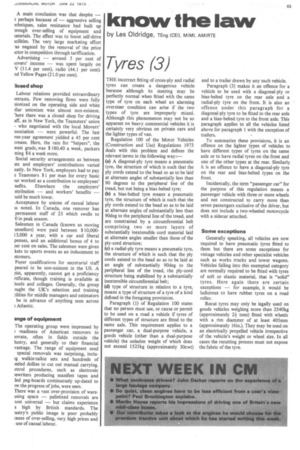know the law
Page 65

If you've noticed an error in this article please click here to report it so we can fix it.
by Les Oldridge, TEng (CEO, MIMI, AMIRTE
Tyres (3)
THE incorrect fitting of cross-ply and radial tyres can create a dangerous vehicle because although its steering may be perfectly normal when fitted with the same type of tyre on each wheel an alarming oversteer condition can arise if the two types of tyre are improperly mixed. Although this phenomenon may not be so apparent on heavy commercial vehicles it is certainly very obvious on private cars and the lighter types of van.
Regulation 100 of the Motor Vehicles (Construction and Use) Regulations 1973 deals with this problem and defines the relevant terms in the following way:—
(a) A diagonal-ply tyre means a pneumatic tyre, the structure of which is such that the ply cords extend to the bead so as to be laid at alternate angles of substantially less than 90 degrees to the peripheral line of the tread, but not being a bias-belted tyre; (b) a bias-belted tyre means a pneumatic tyre, the structure of which is such that the ply cords extend to the bead so as to be laid at alternate angles of substantially less than 90deg to the peripheral line of the tread, and are constrained by a circumferential belt comprising two or more layers of substantially inextensible cord material laid at alternate angles smaller than those of the ply-cord structure; (c) a radial-ply tyre means a pneumatic tyre, the structure of which is such that the ply cords extend to the bead so as to be laid at an angle of substantially 90deg to the peripheral line of the tread, the ply-cord structure being stabilized by a substantially inextensible circumferential belt; (d) type of structure in relation to a tyre, means a type of structure of a tyre of a kind defined in the foregoing provisions.
Paragraph (1) of Regulation 100 states that no person must use, or cause or permit to be used on a road a vehicle if tyres of different types of structure are fitted to the same axle. This requirement applies to a passenger car, a dual-purpose vehicle, a goods vehicle (other than a dual-purpose vehicle) the unladen weight of which does not exceed 1525kg (approximately 30cwt) and to a trailer drawn by any such vehicle.
Paragraph (3) makes it an offence for a vehicle to be used with a diagonal-ply or bias-belted tyre on the rear axle and a radial-ply tyre on the front. It is also an offence under this paragraph for a diagonal-ply tyre to be fitted to the rear axle and a bias-belted tyre to the front axle. This paragraph applies to all the vehicles listed above for paragraph 1 with the exception of trailers.
To summarize these provisions, it is an offence on the lighter types of vehicles to have different types of tyres on the same axle or to have radial tyres on the front and one of the other types at the rear. Similarly it is an offence to have a diagonal-ply tyre on the rear and bias-belted types on the front.
Incidentally, the term "passenger car" for the purpose of this regulation means a passenger vehicle with three or more wheels and not constructed to carry more than seven passengers exclusive of the driver, but does not include a two-wheeled motorcycle with a sidecar attached.
Some exceptions Generally speaking, all vehicles are now required to have pneumatic tyres fitted to them but there are some exceptions for vintage vehicles and other specialist vehicles such as works trucks and tower wagons. Vehicles falling into this exempted category are normally required to be fitted with tyres of soft or elastic material, that is "solid" tyres. Here again there are certain exceptions — for example, it would be ludicrous to have rubber tyres on a road roller.
Recut tyres may only be legally used on goods vehicles weighing more than 2540kg (approximately 2+ tons) fitted with wheels with a rim diameter of at least 405mm (approximately 16in.). They may be used on an electrically propelled vehicle irrespective of the vehicle's weight or wheel size. In all cases the recutting process must not expose the fabric of the tyre.




















































































































